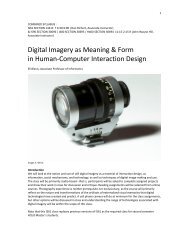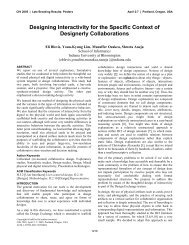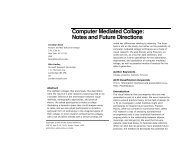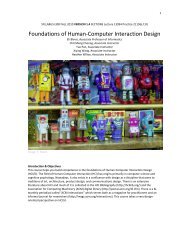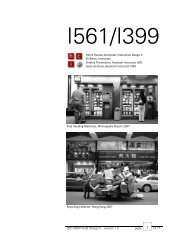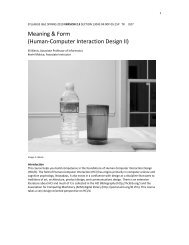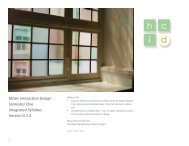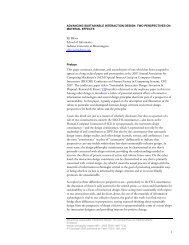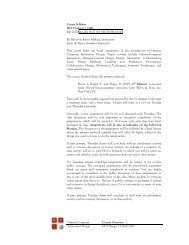Human-Computer Interaction Design Master of Science Program ...
Human-Computer Interaction Design Master of Science Program ...
Human-Computer Interaction Design Master of Science Program ...
Create successful ePaper yourself
Turn your PDF publications into a flip-book with our unique Google optimized e-Paper software.
<strong>Human</strong>-<strong>Computer</strong><br />
<strong>Interaction</strong> <strong>Design</strong><br />
<strong>Master</strong> <strong>of</strong> <strong>Science</strong><br />
<strong>Program</strong> Handbook<br />
School <strong>of</strong> Informatics & Computing<br />
Indiana University, Bloomington IN USA<br />
2011/2012 | Version 0.3<br />
1
Top right:<br />
Jennifer Lasimbang’s 2004 HCI/d MS Capstone Poster.<br />
Jennifer established an information and communication<br />
technologies for development (ICT4D) center in a remote<br />
village in Malaysia.<br />
Bottom right:<br />
Matt Hottell’s 2004 HCI/d MS Capstone Poster. Matt studied<br />
the disconnects between the design <strong>of</strong> contemporaneous<br />
computing devices and children’s’ cognitive and motor<br />
tactile skills. He proposed solutions to make computers more<br />
child friendly.<br />
Opposite:<br />
New digital technologies will allow focus to be selected<br />
after an image has been taken rather than before! These<br />
technologies have been developed by our colleague at<br />
the School <strong>of</strong> Informatics & Computing, Andrew Lumsdaine,<br />
and his colleagues. In the HCI/d program, we don’t typically<br />
invent new technologies; rather, we study and design<br />
for their use and implications. Understanding the impacts<br />
<strong>of</strong> and designing for the implications and potential uses <strong>of</strong><br />
new trends in digital technology is one <strong>of</strong> the competencies<br />
that is central to HCI/d.<br />
Cover:<br />
The idea <strong>of</strong> selective focus is a visual metaphor for our<br />
program, which has three main career goal themes,<br />
namely (i) interaction design, (ii) strategic design planning,<br />
and (iii) research, scholarship, & creative activity.<br />
3
4<br />
Contents<br />
1. Introduction<br />
2. HCI/d MS <strong>Program</strong> Structure<br />
3. Course Descriptions<br />
4. For Reference<br />
Kindly note that this handbook has been revised very<br />
extensively, this year—with so many changes, it should be<br />
considered as somewhat <strong>of</strong> a draft copy. Please allow for<br />
changes and additions to follow. Kindly direct questions<br />
about this document to Eli Blevis—eblevis@indiana.edu
1. Introduction<br />
This handbook details the <strong>Master</strong> <strong>of</strong> <strong>Science</strong> (MS)<br />
program in <strong>Human</strong>-<strong>Computer</strong> <strong>Interaction</strong> <strong>Design</strong><br />
(HCI/d) at the School <strong>of</strong> Informatics & Computing,<br />
Indiana University, Bloomington, Indiana USA.<br />
The Core HCI/d Faculty are:<br />
Jeff Bardzell<br />
Associate Pr<strong>of</strong>essor <strong>of</strong> Informatics<br />
Shaowen Bardzell<br />
Assistant Pr<strong>of</strong>essor <strong>of</strong> Informatics<br />
Eli Blevis<br />
Associate Pr<strong>of</strong>essor <strong>of</strong> Informatics,<br />
Director <strong>of</strong> the HCI/d <strong>Program</strong><br />
Marty Siegel<br />
Pr<strong>of</strong>essor <strong>of</strong> Informatics,<br />
Director <strong>of</strong> Graduate <strong>Program</strong>s for Informatics<br />
Erik Stolterman<br />
Pr<strong>of</strong>essor <strong>of</strong> Informatics,<br />
Division Chair for Informatics<br />
The Staff associated with this program are:<br />
Patty Reyes-Cooksey,<br />
Director <strong>of</strong> Graduate Administration<br />
Linda Hostetter, Graduate Recorder<br />
Cheryl Engel, Admissions Assistant<br />
Jeremy Podamy, Director <strong>of</strong> Career Services<br />
Kindly refer to www.soic.indiana.edu for contact and<br />
other details <strong>of</strong> these faculty and staff.<br />
The Director <strong>of</strong> the HCI/d program—Pr<strong>of</strong>. Eli Blevis—<br />
has the overall responsibility for the program, courses,<br />
and everything else that relates to the program. You<br />
may write to him about the program and once you<br />
are enrolled, you may contact him as well with any<br />
personal issues, concerns, or ideas you may have<br />
affecting your studies or the program or your wellbeing<br />
in general.<br />
The Graduate Director <strong>of</strong> the Informatics MS and<br />
PhD program—Pr<strong>of</strong>. Marty Siegel—is involved in more<br />
overall issues <strong>of</strong> being a graduate student in our<br />
school. You may also contact him with any issues or<br />
concerns, or just to chat. Marty is very friendly and<br />
approachable, with a great reputation for helping<br />
students.<br />
The collective goal <strong>of</strong> the core HCI/d faculty is to<br />
help you succeed in our program as an individual,<br />
while also ensuring that high standards are met as<br />
a collective investment in reputation by all faculty,<br />
students, and alumni who are connected to our program.<br />
Our goal is to be the best design-oriented HCI<br />
program in the world, and each <strong>of</strong> us participates in<br />
this vision.<br />
2. HCI/d MS <strong>Program</strong> Structure<br />
Schedule <strong>of</strong> Classes<br />
The <strong>Master</strong> <strong>of</strong> <strong>Science</strong> Degree <strong>Program</strong> in HCI/d<br />
consists <strong>of</strong> 36 credit hours <strong>of</strong> studies, normally taken<br />
over two consecutive years, evenly distributed as 3<br />
classes or 9 credit hours per semester.<br />
The schedules on the following pages show the<br />
classes you will take. There is some choice available<br />
in the second year <strong>of</strong> study in the form <strong>of</strong> electives.<br />
Since this is a two year program, the schedule shows<br />
classes in whole or in part for three different cohorts:<br />
The Class <strong>of</strong> 2012<br />
Year 2 Fall 2011<br />
Year 2 Spring 2012<br />
The Class <strong>of</strong> 2013<br />
Year 1 Fall 2011<br />
Year 1 Spring 2012<br />
Year 2 Fall 2012<br />
Year 2 Spring 2013<br />
The Class <strong>of</strong> 2014<br />
Year 1 Fall 2012<br />
Year 1 Spring 2013<br />
Kindly read these schedules keeping your respective<br />
cohort in mind.<br />
5
6<br />
Class Schedule: 2011/2012<br />
Year 1 Fall 2011 Year 1 Spring 2012 Year 2 Fall 2011 Year 2 Spring 2012<br />
I541 <strong>Interaction</strong> <strong>Design</strong> Practice<br />
(IDP) Marty Siegel<br />
I542 Foundations <strong>of</strong> HCI/d<br />
Jeff Bardzell<br />
I590 Visual Literacy in HCI/d (I/<br />
H400)<br />
Eli Blevis<br />
Bold course numbers denote required classes.<br />
I543 User Research Methodologies<br />
Shaowen Bardzell<br />
I544 Experience <strong>Design</strong><br />
Erik Stolterman<br />
I561 Digital Imagery as Meaning &<br />
Form in HCI/d (DIMF)<br />
Eli Blevis<br />
I590 Prototyping<br />
Dan Richert<br />
FINA S552 Graphics<br />
Tom Walker<br />
Electives (Select 1):<br />
I590 Rapid <strong>Design</strong> for Slow Change<br />
Marty Siegel<br />
Free Choice<br />
I694 Capstone (6 Credits)<br />
Jeff Bardzell, Eli Blevis<br />
Electives (Select 1):<br />
I590 <strong>Interaction</strong> Culture<br />
Jeff Bardzell<br />
Free Choice
Class Schedule: 2012/2013 (projected, subject to change)<br />
Year 1 Fall 2012 Year 1 Spring 2013 Year 2 Fall 2012 Year 2 Spring 2013<br />
I541 <strong>Interaction</strong> <strong>Design</strong> Practice<br />
(IDP) Marty Siegel<br />
I542 Foundations <strong>of</strong> HCI/d<br />
Jeff Bardzell<br />
I590 Visual Literacy in HCI/d (I/<br />
H400)<br />
Eli Blevis<br />
Bold course numbers denote required classes.<br />
I543 User Research Methodologies<br />
Shaowen Bardzell<br />
I544 Experience <strong>Design</strong><br />
Jeff Bardzell<br />
I561 Digital Imagery as Meaning &<br />
Form in HCI/d (DIMF)<br />
Eli Blevis<br />
I590 Prototyping<br />
Shaowen Bardzell<br />
FINA S552 Graphics<br />
Tom Walker<br />
Electives (Select 1):<br />
I590 Rapid <strong>Design</strong> for Slow Change<br />
Marty Siegel<br />
Free Choice<br />
I694 Capstone (6 Credits)<br />
Jeff Bardzell, Eli Blevis<br />
Electives (Select 1):<br />
I590 <strong>Interaction</strong> Culture<br />
Jeff Bardzell<br />
I604 <strong>Design</strong> Theory<br />
Erik Stolterman<br />
Free Choice<br />
7
8<br />
HCI/d MS <strong>Program</strong> Structure<br />
Career Goal Themes<br />
There are three main career goal themes in the program.<br />
These are:<br />
1. <strong>Interaction</strong> <strong>Design</strong><br />
2. Strategic <strong>Design</strong> Planning<br />
3. Research, Scholarship, & Creative Activity<br />
Every student will participate in class work relating<br />
to each one <strong>of</strong> these themes. Most students will<br />
emphasize one theme over another depending on<br />
individual career goals. It is very important to understand<br />
that your views <strong>of</strong> the programmatic material<br />
will vary depending on which theme relates to your<br />
particular career goals and to appreciate that some<br />
students may emphasize a different theme than you.<br />
You should expect to achieve a baseline pr<strong>of</strong>iciency<br />
in all three themes, and take seriously the choice <strong>of</strong><br />
which <strong>of</strong> these three themes will guide your career.<br />
As a general rule, expect that each cohort will selfdistribute<br />
approximately evenly over these three<br />
themes. If at the outset <strong>of</strong> the program, you do not<br />
know which <strong>of</strong> these three themes most appeals to<br />
you, do not worry—you will have plenty <strong>of</strong> exposure<br />
to these three themes over the course <strong>of</strong> the program<br />
and this choice should become clear to you as<br />
you start your second year, if not before.<br />
<strong>Interaction</strong> <strong>Design</strong><br />
The theme <strong>of</strong> interaction design will appeal most to<br />
those students who want to design products using<br />
the materials <strong>of</strong> digital technologies. If you want to<br />
pr<strong>of</strong>essionally design interfaces, interactive applications,<br />
social networking sites, digital products, and<br />
so on and so forth, interaction design is the theme<br />
for you. In our program, interaction design is always<br />
a values-rich theme—we require that everything<br />
we design adds genuine and sustainable value to<br />
peoples’ lives and respects humankind’s relationship<br />
to the natural environment.<br />
Strategic <strong>Design</strong> Planning<br />
The theme <strong>of</strong> strategic design planning will appeal<br />
most to students who want to start their own design<br />
consultancies, or who want to achieve executive<br />
level positions and influence in design firms or other<br />
firms that make use <strong>of</strong> digital technologies, or who<br />
want to pioneer systemic design innovations for<br />
social good. If you want to design strategy from the<br />
perspectives <strong>of</strong> social values, technological insights,<br />
and enterprise considerations, strategic design planning<br />
is the theme for you.<br />
Research, Scholarship, & Creative Activity<br />
The theme <strong>of</strong> research, scholarship, & creative activity<br />
will appeal most to students who are considering<br />
a career in scholarship, as a pr<strong>of</strong>essor or researcher.<br />
The table on the following page shows approxi-<br />
mately how these themes are distributed in emphasis<br />
among the various required courses and elective<br />
courses taught by the core faculty.
Career<br />
Goal<br />
Themes<br />
Year 1 Fall Year 1 Spring Year 2 Fall Year 2 Spring<br />
I541 I542 I590 I543 I544 I561 I590 FINA S552 I590 I694 I590<br />
<strong>Interaction</strong> Founda- Visual User Experi- Digital Prototyp- Graphics Rapid Capstone <strong>Interaction</strong><br />
<strong>Design</strong> tions <strong>of</strong> Literacy in Research ence Imagery ing Tom <strong>Design</strong> (6 Credits) Culture<br />
Practice HCI/d HCI/d (I/ Method- <strong>Design</strong> as Mean- Shaowen Walker for Slow Jeff Jeff<br />
(IDP) Jeff H400) ologies Jeff ing & Form Bardzell<br />
Change Bardzell & Bardzell<br />
Marty Bardzell Eli Blevis Shaowen Bardzell/ in HCI/d<br />
Marty Eli Blevis<br />
Siegel<br />
Bardzell Erik Stolter- (DIMF)<br />
Siegel<br />
man Eli Blevis<br />
I604<br />
<strong>Design</strong><br />
Theory<br />
Erik<br />
Stolterman<br />
<strong>Interaction</strong><br />
<strong>Design</strong> ■ ○ □ ■ ■ ○ ■ ○ ■ □ □ ○<br />
Strategic<br />
<strong>Design</strong> □ ○ ■ ○ ○ ■ ○ □ □ □ ○ □<br />
Planning<br />
Research,<br />
Scholarship,<br />
&<br />
Creative<br />
Activity<br />
○ ■ ○ □ □ □ □ ■ ○ □ ■ ■<br />
■ : primary focus □ : secondary focus ○ : tertiary focus<br />
9
Background:<br />
As an example <strong>of</strong> a portfolio piece,<br />
In “Clockwork Moths,” Shad Gross<br />
illustrates not only considerable<br />
pyrotechnical Photoshop skills,<br />
but also provides an image that<br />
deeply pushes the limits <strong>of</strong> the<br />
modern digital commons. The work<br />
is composed mainly from materials<br />
provided by Shad Gross, himself,<br />
but additionally is derivative from<br />
parts <strong>of</strong> images that are licensed<br />
under creative commons and other<br />
forms <strong>of</strong> relaxed copyright. Some <strong>of</strong><br />
the images used in the composite<br />
image may only be used in derivative<br />
work, some <strong>of</strong> the images may<br />
be used for derivative work with<br />
attribution, and some <strong>of</strong> the images<br />
may be used for derivative work just<br />
in the case that others are free to<br />
use the resulting image. The images<br />
used here are: BronzeCopper0027<br />
(Texture: #11578), Insects0001 (Texture:<br />
#18081), Insects0007 (Texture:<br />
#19473) from www.cgtextures.<br />
com; Christina Rutz www.flickr.com/<br />
photos/paparutzi/252725115/; Steve<br />
Jurvetson www.flickr.com/photos/<br />
jurvetson/17945646/; User “history_<br />
aficianado” www.flickr.com/photos/history_aficionado/532658724/;<br />
User “timlewisnm” www.flickr.com/<br />
photos/gozalewis/3256814461/.<br />
10<br />
HCI/d MS <strong>Program</strong> Structure<br />
Portfolio Development<br />
One <strong>of</strong> the most important aspects <strong>of</strong> our program is<br />
that it gives you a chance to develop your individual<br />
web-based portfolio. The portfolio consists <strong>of</strong> presentations<br />
<strong>of</strong> your learning experiences in the form<br />
<strong>of</strong> designs, writings, projects, and so on and so forth.<br />
The portfolio reflects your very personal competence<br />
and skills. When applying for a job or a Ph.D. program,<br />
your portfolio will be as important or maybe<br />
more important than your course work.<br />
You will begin to put together your portfolio, if you<br />
don’t already have one, in I590 Visual Literacy in<br />
HCI/d. You will create lots <strong>of</strong> content for your portfolio<br />
in the course <strong>of</strong> study <strong>of</strong> nearly all <strong>of</strong> the classes<br />
you take.
HCI/d MS <strong>Program</strong> Structure<br />
Electives<br />
The curriculum endeavors to meet the goals <strong>of</strong> the<br />
program, but elective coursework is available as<br />
well. Electives allow students the freedom to customize<br />
their education to meet their personal interests<br />
and needs and these courses may come from any<br />
department at Indiana University (with permission<br />
from that department).<br />
The opportunity to take electives is ordinarily avail-<br />
able only in the second year <strong>of</strong> study, except in<br />
special circumstances.<br />
Specializations<br />
A specialization is a special expertise that you wish<br />
to develop while in the HCI/d program. The choice<br />
<strong>of</strong> specialization may be tailored to the individual<br />
student. Common areas <strong>of</strong> specialization will include:<br />
computing, education, business, communications,<br />
psychology, new media, gaming, sports, security,<br />
music, and research methods. Your choice <strong>of</strong> specialization<br />
area determines some aspects <strong>of</strong> your<br />
capstone project. For example, if you care deeply<br />
about entrepreneurship, you may wish to include a<br />
detailed strategic business plan in your project deliverables.<br />
If you care deeply about s<strong>of</strong>tware, you may<br />
wish to construct working prototypes or an especially<br />
detailed implementation specification beyond the<br />
basic requirements. If you care deeply about communications,<br />
you may wish to construct compelling<br />
appearance prototypes. If you care deeply about<br />
usability, you may wish to emphasize observation<br />
techniques or possibly uncover new and unique<br />
ways <strong>of</strong> understanding users. Specialization courses<br />
(electives) should be chosen with the help <strong>of</strong> the<br />
program director or an HCI/d faculty member.<br />
Independent Studies<br />
An independent study is a course that you develop<br />
in close relation to a pr<strong>of</strong>essor in an area that is <strong>of</strong><br />
interest both for you and the pr<strong>of</strong>essor. An independent<br />
study can be a way for you to do more design<br />
oriented work or more research oriented work.<br />
To initiate an independent study, you need to find a<br />
faculty member--not necessarily a faculty member in<br />
the core area <strong>of</strong> HCI/d--who is willing to advise your<br />
independent study. There is a form which you can<br />
obtain from Linda Hostetter that needs to be filled<br />
out and approved by the faculty member and the<br />
program director.<br />
In special circumstances, an internship which ex-<br />
tends beyond the summer can be used to create an<br />
independent study. Speak or write to the program<br />
director if you are considering this option.<br />
11
12<br />
3. HCI/d MS Course Descriptions<br />
Introduction<br />
The following is a list <strong>of</strong> course descriptions as supplied<br />
by the faculty at the time <strong>of</strong> writing. To be<br />
certain you have the latest descriptions, it is a good<br />
idea to check the web sites <strong>of</strong> the various faculty for<br />
up-to-date course descriptions--where available,
HCI/d MS Course Descriptions<br />
I541 <strong>Interaction</strong> <strong>Design</strong> Practice<br />
(IDP) Marty Siegel<br />
The goal <strong>of</strong> this course is to begin the transformation<br />
from non-designer to (interaction) designer.<br />
The following topics are listed in approximately the<br />
order they will be uncovered—from Norman’s notion<br />
<strong>of</strong> the design <strong>of</strong> everyday things to the design<br />
<strong>of</strong> s<strong>of</strong>tware; old and new design models; mock ups,<br />
sketches, and how they are used; seven themes<br />
<strong>of</strong> good design, presented as a whole and then<br />
individually throughout the semester; group decision<br />
protocols; guidelines for critiquing designs; thinking<br />
like an architect; thinking like an instructional designer;<br />
problem-based learning tools: for information<br />
systems, for academic and corporate learning, for<br />
visualization <strong>of</strong> data, etc.; thinking like a graphic designer;<br />
thinking like a (composer, novelist, playwright,<br />
or choreographer); interactive instruction: a case<br />
for computer imagination; computer-based training:<br />
a new view; design <strong>of</strong> information appliances;<br />
post-mortem analysis; time management challenges;<br />
philosophy and ethics <strong>of</strong> design. Throughout the<br />
course, these topics will be interspersed: case studies<br />
(a variety <strong>of</strong> web and real products); critiques <strong>of</strong><br />
design projects; life in the trenches as an interactive<br />
systems designer; pr<strong>of</strong>essionalism as an interaction<br />
designer; and the philosophy <strong>of</strong> design. These topics<br />
will play out through the group design <strong>of</strong> five realworld<br />
and challenging design projects, with the last<br />
project culminating as a submission to the annual<br />
CHI International Student <strong>Design</strong> Competition.<br />
I542 Foundations <strong>of</strong> HCI/d<br />
Jeff Bardzell<br />
Foundations <strong>of</strong> HCI <strong>of</strong>fers a survey overview <strong>of</strong> the<br />
field <strong>of</strong> <strong>Human</strong>-<strong>Computer</strong> <strong>Interaction</strong> <strong>Design</strong>. It<br />
introduces the main themes <strong>of</strong> HCI setgenerally in a<br />
historical context.<br />
Compared to more mature disciplines, such as Biology<br />
or English, HCI is young and still finding its intellectual<br />
identity and agenda. An applied and interdisciplinary<br />
field, HCI reflects concerns from cognitive<br />
science, sociology, engineering, philosophy, design,<br />
management, and digital media studies. Today, HCI<br />
is undergoing major intellectual shifts from an older<br />
paradigm <strong>of</strong> HCI that integrated cognitive science,<br />
engineering, and traditional social science, to a<br />
newer paradigm that integrates design and humanistic<br />
approaches. Much <strong>of</strong> Indiana’s HCID curriculum<br />
reflects a forward-look to the rising paradigm <strong>of</strong> HCI.<br />
However, understanding HCI’s rising paradigm<br />
requires a holistic understanding <strong>of</strong> both the accomplishments<br />
(e.g., usability) and limitations <strong>of</strong><br />
earlier paradigms. It also assumes some understanding<br />
relationships between emerging technologies in<br />
the past decades and research and practice in HCI<br />
as a field. Finally, practicing the rising paradigm <strong>of</strong><br />
interaction design requires an understanding <strong>of</strong> how<br />
older approaches remain relevant to and continue<br />
to inform newer approaches. I542: Foundations <strong>of</strong><br />
HCI is just such a survey.<br />
I590 Visual Literacy in HCI/d<br />
Eli Blevis<br />
This is a new course that is required for first year HCI/d<br />
MS students. The course will be a <strong>Design</strong> Challengse<br />
Based Learning (DCBL) skills oriented class targeted<br />
at acquiring specific competencies with Illustrator,<br />
In<strong>Design</strong>, direct coding in HTML, CSS and the relationship<br />
<strong>of</strong> CSS to typesetting, secondarily Lightroom,<br />
Photoshop, and presentation preparation, but not<br />
Flash nor PHP nor Java etc. It is open also to undergraduates<br />
who have done well in I300, or are similarly<br />
qualified.<br />
The class is in three parts, namely<br />
PART 1 – Structuring <strong>Design</strong> Explanations for Slide-sets,<br />
Web, and Print<br />
PART II – Technical Illustration, Diagrammatic Reason-<br />
ing & Sequencing<br />
PART III – Integrating Visual Literacy into <strong>Design</strong><br />
13
HCI/d MS Course Descriptions<br />
I543 User Research Methodologies<br />
Shaowen Bardzell<br />
The course introduces students to data collection<br />
and analysis techniques commonly used in <strong>Human</strong><br />
<strong>Computer</strong> <strong>Interaction</strong>. Students will learn and practice<br />
both traditional human-centered design methods<br />
as well as newer methodologies from anthropology<br />
and the humanities to understand people’s<br />
uses <strong>of</strong> technological artifacts and the contexts in<br />
which these occur. Such methods are used to help<br />
reveal user needs and requirements; more broadly,<br />
these methodologies also seek to help interaction<br />
designers understand needs, values, and qualities <strong>of</strong><br />
good interaction and implement them in interactive<br />
technologies.<br />
Students are expected to conduct fieldwork in indi-<br />
vidual and small teams throughout the course: user<br />
research is a pr<strong>of</strong>essional skill that must be practiced<br />
to be learned.<br />
14<br />
I544 Experience <strong>Design</strong><br />
Jeff Bardzell/Erik Stolterman<br />
The focus <strong>of</strong> HCI is moving beyond efficiency and<br />
productivity. <strong>Computer</strong>s are a part <strong>of</strong> our everyday<br />
lives, and we use them to connect to friends and<br />
family, create and manage our personal music and<br />
photo libraries, explore fantastic new worlds with<br />
virtual friends, view mass and viral media, network<br />
pr<strong>of</strong>essionally, and pursue our hobbies. <strong>Computer</strong><br />
interfaces are no longer tools we use to accomplish<br />
tasks; they are the environments in which we work,<br />
play, relax, love, and kill time. As a result, designers<br />
are increasingly focusing on creating experiences,<br />
rather than interfaces. This shift in focus implies a corresponding<br />
shift in the conceptualization, methodologies,<br />
and practice <strong>of</strong> HCI.<br />
In this course, students will be introduced to anthro-<br />
pological and philosophical conceptualizations<br />
<strong>of</strong> human experience and then, guided by recent<br />
HCI literature, apply that understanding to interaction<br />
design. In a highly participatory environment,<br />
students will examine design artifacts, from Japanese<br />
punk fashion to Chicago skyscrapers, using theories<br />
from visual culture, simultaneously critiquing these<br />
designs and sketching new ones based on them.<br />
As a final project, students will develop a series <strong>of</strong><br />
experience prototypes before designing a universally<br />
accessible educational museum exhibit.<br />
I561 Digital Imagery as Meaning<br />
& Form in HCI/d (DIMF) Eli Blevis<br />
We will look at the notion and use <strong>of</strong> still digital<br />
imagery as a material <strong>of</strong> interaction design, as<br />
information, social mechanisms, and technology,<br />
as well as techniques <strong>of</strong> digital image making and<br />
use. The class will be primarily studio-based--that<br />
is, participants will be asked to complete assigned<br />
projects and show their work in class for discussion<br />
and critique. Reading assignments will be selected<br />
from online sources. Photography experience is<br />
neither prerequisite nor exclusionary, as the course<br />
will primarily reflect on the nature and transformations<br />
<strong>of</strong> the artifacts <strong>of</strong> externalized visual memories<br />
that digital technologies have created and predict.<br />
A cell phone camera will do at minimum for the class<br />
assignments, but other options will be discussed in<br />
class and understanding the range <strong>of</strong> technologies<br />
associated with digital imagery will be within the<br />
scope <strong>of</strong> this class.
HCI/d MS Course Descriptions<br />
I590 Prototyping<br />
Shaowen Bardzell/Dan Richert<br />
Prototyping is the activity <strong>of</strong> exploring a design<br />
space and trying out design ideas. In interaction<br />
design, common prototyping techniques include<br />
screen sketches, storyboards with a series <strong>of</strong> scenes,<br />
a PowerPoint slide show, a video simulating the use<br />
<strong>of</strong> a system, a cardboard mock-up, or a piece <strong>of</strong><br />
s<strong>of</strong>tware with limited functionality.<br />
In this course, we will explore issues surrounding the<br />
construction <strong>of</strong> prototypes (e.g., breath, depth, look,<br />
interaction, low/high, vertical/horizontal, serial/parallel,<br />
etc.) as well as learning how to interact and manipulate<br />
different materials from papers, foam core,<br />
to digital sensors to communicate design ideations<br />
and concepts. Students will also learn about and<br />
practice different prototype evaluation techniques,<br />
including cognitive walkthroughs, heuristic evaluation,<br />
and interaction criticism, among others.<br />
FINA S552 Graphics/Typography<br />
Tom Walker<br />
This class is <strong>of</strong>fered in two sections, in order to keep<br />
the learning setting small. The class will focus on<br />
creating meaning with elements <strong>of</strong> form and the<br />
historical significance <strong>of</strong> typography and graphics<br />
in relation to design-oriented disciplines. This is an<br />
important course which will allow you to apply the<br />
skills you will have acquired in the earlier classes in<br />
pr<strong>of</strong>ound ways.<br />
I590 Rapid <strong>Design</strong> for Slow<br />
Change (RDSC) Marty Siegel<br />
This is an elective class.<br />
Whether it’s diet, exercise, disease prevention,<br />
addiction recovery, financial planning, citizenship<br />
awareness, or environmental responsibility, appropriate<br />
behaviors in these and similar domains are particularly<br />
challenging to initiate and sustain. Moreover,<br />
web sites that support these behaviors are unsuccessful<br />
for many people beyond an initial period <strong>of</strong><br />
compliance.<br />
Why are these intractable behaviors unsustainable?<br />
Do our modern technologies and ubiquitous access<br />
conspire against us? For designers, are there new<br />
considerations or principles beyond current practice<br />
that should be applied to these domains? We refer<br />
to this design research, characterized by initiating<br />
and sustaining slow behavioral change, as “slow<br />
change interaction design” (SCID). These issues provide<br />
the backdrop <strong>of</strong> this course. For the designer,<br />
SCID problems are particularly messy, ill structured,<br />
and wicked.<br />
The course will be divided into five parts – (1) a<br />
theoretical exploration <strong>of</strong> slow change; (2) exemplar<br />
exploration <strong>of</strong> slow change; (3) rapid design practice<br />
(general problems); (4) rapid design practice (specific<br />
to slow change problems); and (5) a culminating<br />
SCID project. Each rapid design practice project<br />
will last one week or less; the final SCID project will<br />
last five weeks.<br />
15
HCI/d MS Course Descriptions<br />
I590 <strong>Interaction</strong> Culture<br />
Jeff Bardzell<br />
Interactive technologies’ move from the workplace<br />
and into everyday life entails far more than<br />
changes in UI widgets. Technological forms (e.g.,<br />
mobile devices, tabletop interaction, and information<br />
appliances) and design practices (e.g., design<br />
research, prototyping and evaluation) alike are<br />
undergoing pr<strong>of</strong>ound changes. Among the root<br />
causes <strong>of</strong> these changes is the rising significance <strong>of</strong><br />
culture to interaction. <strong>Interaction</strong> design increasingly<br />
takes issues such as emotion, user experience, social<br />
change and social justice, cultural differences (e.g.,<br />
between the West and the developing world), and<br />
aesthetic interaction more seriously, and many <strong>of</strong> the<br />
field’s traditional approaches, such as usability and<br />
workplace studies, are not positioned well to support<br />
these forms <strong>of</strong> contemporary interaction design.<br />
The field <strong>of</strong> design, which includes product and<br />
industrial design, architecture, fashion, interior design<br />
and urban planning, service design, and graphic<br />
design among others, has increasingly been turned<br />
to as a new resource for HCI. One reason for the rise<br />
<strong>of</strong> design in HCI has been its strengths in applying<br />
cultural sophistication to understanding and designing<br />
for human needs. For example, not only do our<br />
clothes protect us from the elements, but they also<br />
help us express personal, pr<strong>of</strong>essional, and/or national<br />
identities; relate to others appropriately in diverse<br />
social situations; and just feel good against our skin.<br />
The kind <strong>of</strong> cultural sophistication that is applied in<br />
design situations is not, however, primarily acquired<br />
16<br />
I694 Capstone Thesis Project<br />
Jeff Bardzell & Eli Blevis<br />
By the time you get to the Capstone class in the last<br />
semester <strong>of</strong> the program, you should have a clear<br />
choice <strong>of</strong> which <strong>of</strong> the three career goal themes described<br />
earlier you intend to follow. Your Capstone<br />
project or thesis will take the form <strong>of</strong> (i) an interaction<br />
design project, or (ii) a strategic design plan, or (iii) a<br />
thesis in the genre <strong>of</strong> scholarship, research, & creative<br />
activity. The class will be run studio style in two<br />
3.5 hour sessions per week. This class will be not at all<br />
like previous years and is completely redesigned for<br />
2012.<br />
empirically through surveys and observational studies.<br />
More commonly, this skill is acquired through an<br />
ongoing reflective encounter with cultural artifacts,<br />
including design artifacts, works <strong>of</strong> art, and crafts. Using<br />
the practice <strong>of</strong> critique, designers develop both<br />
theoretical and practical understandings <strong>of</strong> designs<br />
as they participate in and constitute everyday life.<br />
I590 <strong>Interaction</strong> Culture introduces students to the<br />
major strategies <strong>of</strong> interaction criticism, bringing together<br />
a combination <strong>of</strong> critical theories and a wide<br />
range <strong>of</strong> examples, from the arts (including film and<br />
digital media), design (including interaction design<br />
and fashion), and craft (including both digital and<br />
traditional crafts).<br />
I604 <strong>Design</strong> Theory<br />
Erik Stolterman<br />
This course focuses on creating a developed intellectual<br />
understanding <strong>of</strong> complex pr<strong>of</strong>essional design<br />
processes. An underlying assumption is that a reflective<br />
and philosophical understanding <strong>of</strong> practice<br />
supports and fosters a developed practical design<br />
competence.<br />
In the course we will therefore examine, analyze,<br />
study, and discuss how design can be understood,<br />
described, and developed as a process <strong>of</strong> inquiry,<br />
thought, and action.
一览众山小 况达<br />
When you are on the highest mountain,<br />
all other mountains look small<br />
by the Chinese painter Kuang Da<br />
Ink. 200x100cm. 2011. Reproduced here with<br />
permission <strong>of</strong> the artist.<br />
17
Dan Richert, Lecturer<br />
18<br />
4. For Reference<br />
Additional Materials<br />
In this, the final section <strong>of</strong> this handbook, we include<br />
various items material to the program for your reference.
For Reference<br />
Seminar Series<br />
We provide our <strong>Master</strong>’s degree students with the<br />
opportunity to attend seminars by distinguished<br />
faculty and insightful practitioners with the purpose<br />
to broaden and stimulate your intellectual development.<br />
The School organizes weekly Colloquia with invited<br />
speakers. There is an Honors Seminar Series that<br />
will be open for all students, and there are the HCI/d<br />
Seminars as well. Participation in these seminars<br />
deepens and enriches your Informatics experience.<br />
Plagiarism<br />
One <strong>of</strong> the highest values in an academic setting<br />
is the generation <strong>of</strong> new ideas while building<br />
on the work <strong>of</strong> others. Not providing appropriate<br />
credit when borrowing, either directly or in your own<br />
words, is a violation <strong>of</strong> the Indiana University Code<br />
<strong>of</strong> Student Rights, Responsibilities, and Conduct (see:<br />
dsa.indiana.edu/Code/index1.html). The violation is<br />
called “plagiarism” and it is considered a serious ethical<br />
violation in U.S. academic institutions.<br />
Specifically, the Code defines plagiarism as “present-<br />
ing someone else’s work, including the work <strong>of</strong> other<br />
students, as one’s own. Any ideas or materials taken<br />
from another source for either written or oral use<br />
must be fully acknowledged, unless the information is<br />
common knowledge. What is considered ‘common<br />
knowledge’ may differ from course to course.<br />
• A student must not adopt or reproduce ideas,<br />
opinions, theories, formulas, graphics, or pictures<br />
<strong>of</strong> another person without acknowledgment.<br />
• A student must give credit to the originality <strong>of</strong><br />
others and acknowledge indebtedness whenever:<br />
1. Directly quoting another person’s actual<br />
words, whether oral or written;<br />
2. Using another person’s ideas, opinions, or<br />
theories;<br />
3. Paraphrasing the words, ideas, opinions, or<br />
theories <strong>of</strong> others, whether oral or written;<br />
4. Borrowing facts, statistics, or illustrative material;<br />
or<br />
5. Offering materials assembled or collected by<br />
others in the form <strong>of</strong> projects or collections<br />
without acknowledgment.”<br />
We urge all students entering the program to review<br />
the entire Code (see the above link) to become<br />
familiar with your rights and responsibilities as an IU<br />
student. To learn more about plagiarism related to<br />
the field <strong>of</strong> HCI, see ACM’s policy at http://www.<br />
acm.org/publications/policies/plagiarism_policy.<br />
You can also learn more at the following site: plagia-<br />
rism.org. Failure to follow the university’s guidelines<br />
could result in failure in your course and expulsion<br />
from IU and the HCI/d graduate program!<br />
19
For Reference<br />
Meet the HCI/d Core Faculty<br />
You can read more about the faculty at:<br />
http://www.soic.indiana.edu/people/faculty.shtml<br />
20<br />
Jeffrey Bardzell<br />
Associate Pr<strong>of</strong>essor <strong>of</strong> Informatics<br />
jbardzel@indiana.edu<br />
(812) 856-1850<br />
Informatics East, Room 352<br />
Shaowen Bardzell<br />
Assistant Pr<strong>of</strong>essor <strong>of</strong> Informatics<br />
selu@indiana.edu<br />
(812) 855-1341<br />
Informatics East, Room 354
Eli Blevis<br />
Associate Pr<strong>of</strong>essor <strong>of</strong> Informatics<br />
eblevis@indiana.edu<br />
(812) 360-3533<br />
Informatics East, Room 340C<br />
Martin Siegel<br />
Pr<strong>of</strong>essor <strong>of</strong> Informatics<br />
msiegel@indiana.edu<br />
(812) 856-1103<br />
Informatics East, Room 340B<br />
Erik A. Stolterman<br />
Pr<strong>of</strong>essor <strong>of</strong> Informatics<br />
estolter@indiana.edu<br />
(812) 856-5803<br />
Informatics East, Room 340A<br />
21



